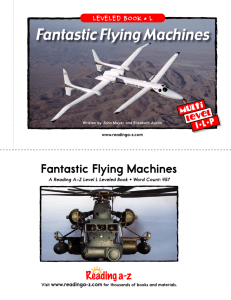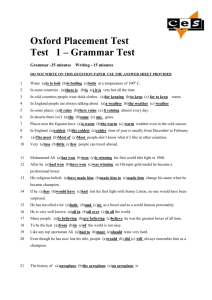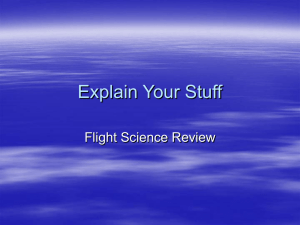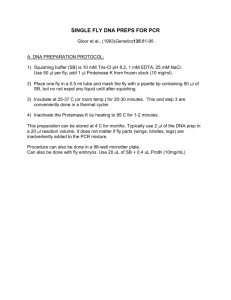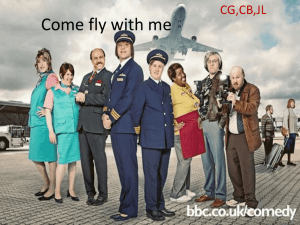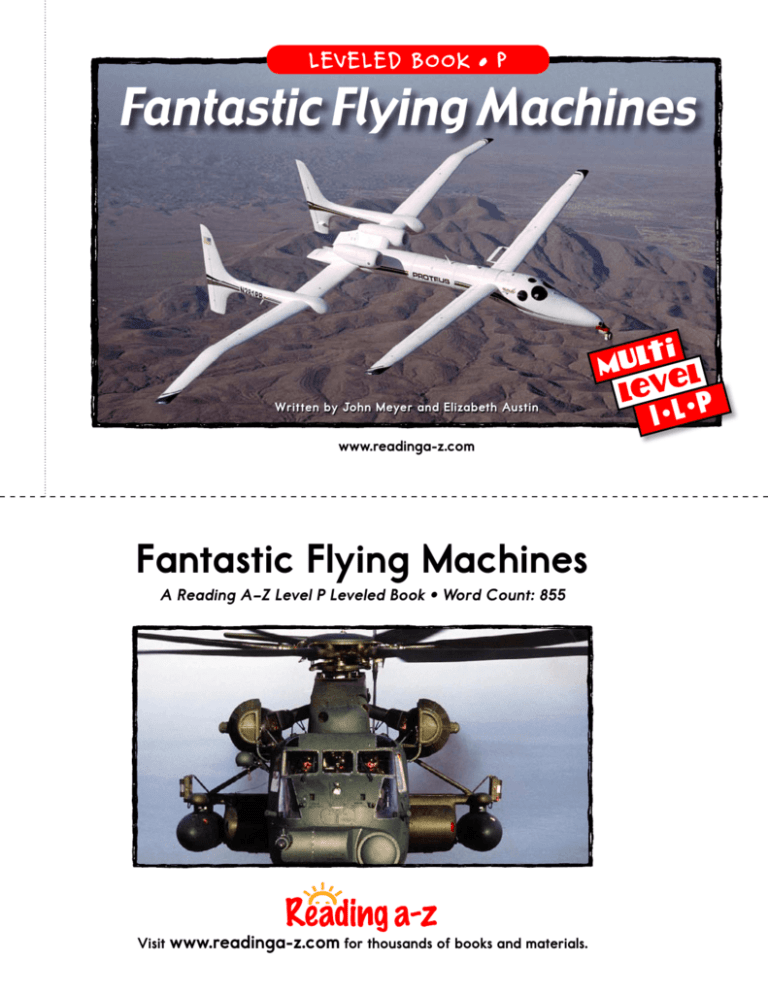
LEVELED BOOK • P
Fantastic Flying Machines
Written by John Meyer and Elizabeth Austin
www.readinga-z.com
Fantastic Flying Machines
A Reading A–Z Level P Leveled Book • Word Count: 855
Visit
www.readinga-z.com for thousands of books and materials.
I•L•P
Photo Credits:
Front cover: Courtesy of Tom Tschida/Dryden Flight Research Center/NASA; back cover, pages 13 (right), 15 (right), 19 (left):
© ArtToday; title page: © Learning A-Z, Inc.; pages 4, 5 (bottom), 15 (left): © Jupiterimages Corporation; pages 5 (top), 6 (left): © The Granger
Collection, NYC; page 6 (right): © Science Museum/SSPL /The Image Works; page 7: courtesy Library of Congress, Prints & Photographs Div
[LC-W861-35]; page 8: © PhotoStock-Israel/Alamy; page 9 (left): courtesy of Photographer’s Mate 3rd Class Todd Frantom/U.S. Navy; page 9
(right): © Ismaeljorda/Dreamstime.com; page 10: © iStockphoto.com/Jason Lugo; page 11: courtesy of U.S. Air Force photo by Staff Sgt. James
Wilkinson; page 12: © ZUMA Press, Inc./Alamy; page 13 (left): courtesy of Airman Kyle T. Voigt /U.S. Navy; page 14: © iStockphoto.com/VMJones;
page16 (left): © Charles Shapiro/iStockPhoto.com; page 16 (right): © Louie Psihoyos/Corbis; pages 17: courtesy of NASA/JSC; page 18 (all):
courtesy of NASA page 19 (right): © Mark Evans/iStockphoto.com
Front cover: The Proteus, a very high-flying observation airplane
Back cover: A military helicopter
Title page: The Lockheed Constellation, used to carry the U.S. president in the 1950s
Fantastic Flying Machines
Level P Leveled Book
© Learning A–Z
Written by John Meyer and Elizabeth Austin
All rights reserved.
www.readinga-z.com
Correlation
LEVEL P
Fountas & Pinnell
Reading Recovery
DRA
M
28
28
www.readinga-z.com
Written by John Meyer and Elizabeth Austin
Fantastic Flying Machines
Table of Contents
Introduction............................................................................................4
History of Flight.....................................................................................6
Airplanes.................................................................................................8
Helicopters..............................................................................................12
Blimps and Balloons..............................................................................15
Rockets and Spaceships........................................................................17
Other Ways to Fly...................................................................................19
Index........................................................................................................20
3
4
Fantastic Flying Machines • Level P
Close your eyes and imagine if you could fly like a bird. Where
would you go? What would you see? If you had never seen or
heard of an airplane, could you imagine what it would be like
to fly? Let’s look at some of the fantastic machines that make
flying possible.
Introduction
People have always wanted to fly. They watched
birds fly. They dreamed about how wonderful
it would be. A few people had good ideas about
what made objects move through the air. One
man made a small toy propeller that could
Leonardo da Vinci’s helicopter
spin through the air. In the 1400s, Leonardo
drawing
da Vinci, an artist, drew amazing plans
for a helicopter. It might have worked—
but he never built it. People experimented.
Some strapped wings onto their arms and
flapped. A few tied themselves to big kites.
Almost everyone crashed over and
over—but they wanted to fly!
These wings flapped when the person
moved his arms and legs.
5
Fantastic Flying Machines • Level P
6
In 1783, two French brothers invented the hot-air balloon. Their first
passengers were a sheep, a rooster, and a duck. George Cayley
built the first glider that carried a person. Later, an engineer
invented a better glider and published his ideas in 1889. A few
years later, his ideas and notes inspired many of the designs
of the Wright brothers.
George Cayley built the first glider
that carried a person.
History of Flight
A sketch of one of Cayley’s first gliders
Wilbur Wright watches his brother Orville make his historic flight.
Orville and Wilbur Wright thought about all of these early ideas.
They thought about why most of them didn’t work. After many
tests, the Wright brothers built the first successful airplane that was
powered by an engine. It could only carry one person, so they took
turns testing it. On December 17, 1903, it was Orville’s turn. That
day, he flew for one full minute and went 260 meters (850 ft).
People could fly!
7
Fantastic Flying Machines • Level P
8
Planes have improved a lot since the early days of flight. Large
passenger airplanes are the first type of flying machine that most
people see. Have you flown in an airplane on a vacation trip?
These types of planes can carry about 450 passengers and their
luggage. They can take you across the country or around the world.
Airplanes
This commercial airplane carries hundreds of passengers around the world every day.
A Navy jet fighter takes off from an aircraft carrier.
Jet gases form streaks of cloud in the sky.
Many planes that are built to fly high or fast use jet engines. Jet
engines are powerful. They push an airplane forward by forcing a
stream, or jet, of hot gas out behind them. Some jets can fly faster
than the speed of sound.
9
Fantastic Flying Machines • Level P
10
This crop duster uses a propeller engine.
Many slower or older
airplanes have propeller
engines. Each blade on
a propeller acts like a
wing. The blades create
air suction when they
spin, like blades on a fan.
This force pulls the plane
forward. Stunt pilots use
small propeller planes
to do tricks at air shows.
Farmers use them to
spray crops.
Helicopters
Helicopters are
another common type
of flying machine.
They can fly and land
almost anywhere.
Most helicopters have
two rotors. The large
rotor on top lifts the
helicopter. A smaller
one on the tail helps
the pilot steer. Unlike A helicopter lands on top of a building.
planes, helicopters can fly backward and rotate. They can even
hover in midair!
12
11
Fantastic Flying Machines • Level P
This plane can hold 132,000 kilograms (291,000 lbs) of cargo.
Some planes are built
for a particular task.
Mail planes deliver
packages overnight.
Military cargo planes
move trucks, supplies,
and troops. Planes
set up as offices allow
people to work while
they fly to business
meetings.
Troops board a military helicopter.
A large helicopter carries a big
bucket of water over a wildfire.
Some helicopters are designed to lift heavy loads. These helicopters
need two rotors on top. Firefighters sometimes use these helicopters
to fight forest fires in remote areas.
13
14
Fantastic Flying Machines • Level P
Helicopters travel faster than cars. Hospitals use helicopters as
ambulances to reach injured people quickly. Police use helicopters
to find and chase criminals. Rescue teams use them to look for
people who are lost.
A helicopter ambulance transports sick and injured people.
Beautiful balloons dot the sky.
Hot-air balloon passengers ride in a basket.
Blimps and Balloons
Hot-air balloons fly very slowly. They can’t be steered, so they drift
where the wind pushes them. Gas burners warm the air inside the
balloons, making them rise in the colder air around them. People
fly in hot-air balloons for fun. It’s a quiet and unusual way to see
the countryside from above.
15
Fantastic Flying Machines • Level P
16
Blimps are flying machines that are often seen above large sporting
events. Blimps are large, long balloons filled with lighter-than-air
gas, such as helium. They usually have two small propeller engines
and can be steered by a pilot—but they fly slowly. Blimps attract
attention, so companies put their names on them for advertising.
Blimps are often used to film sporting events.
Riding in a blimp gives an amazing view.
Rockets and Spaceships
Rockets are very powerful engines
that force hot gases out behind them
to create thrust. In 1957, the Soviet
Union surprised the world when
it used a rocket to launch the first
satellite. The satellite’s name was
Sputnik. It captured everyone’s
imagination. People thought about
space travel—and being astronauts.
Since then, rockets have carried
people to the Moon and have
helped to build a space station.
The Saturn V rocket carried astronauts
to the Moon.
Fantastic Flying Machines • Level P
17
18
A space shuttle rides a rocket into space. It carries astronauts and
supplies to the International Space Station. On its return trip
to Earth, its wings let it land like an airplane.
A space shuttle uses rockets to lift off.
A space shuttle in orbit
A hang glider flies over a beach.
A modern glider aircraft soars in the air.
Other Ways to Fly
Today, there are many ways to fly. Hang gliders take off from cliffs and
glide to the earth, drifting on air currents. In sleek, thin glider aircraft,
people can soar for hours. Long ago, people could only imagine flying
like birds. Now, many people have the chance to fly. Where would you
like to fly?
19
Fantastic Flying Machines • Level P
20
Wright, Orville and Wilbur, 6, 7
space shuttle, 18
rotor, 12, 13
propeller, 5, 10, 16
jet engines, 9
Index

